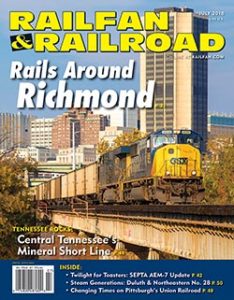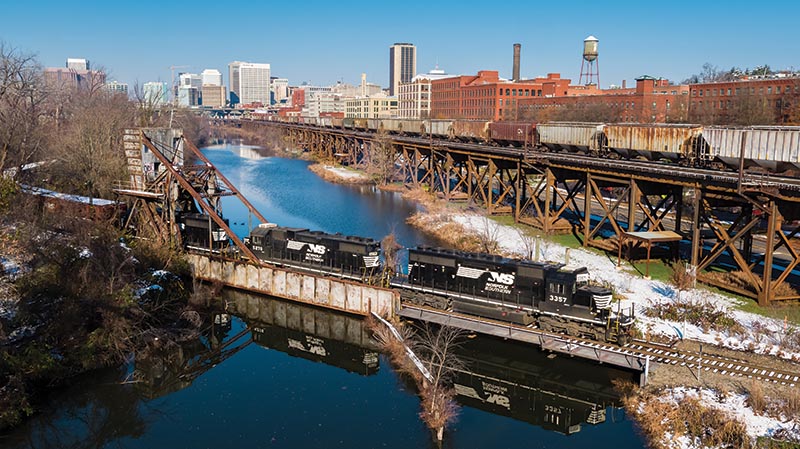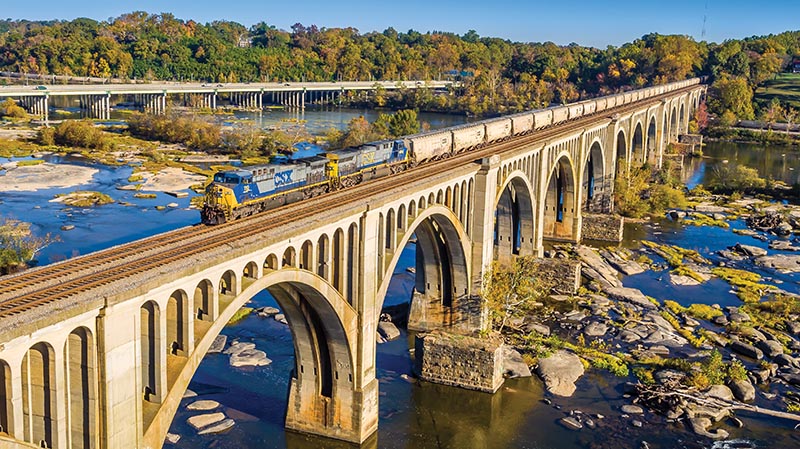 by Justin Ross/photos by the author
by Justin Ross/photos by the author
Built up along the James River, approximately 200,000 residents call Richmond, Va., home. The skyline provides a nice blend of modern skyscrapers and older brick buildings, and there are tobacco warehouses converted to upscale apartments. The city may be small, but has an abundant amount of trains. Two Class I railroads are in the city. The majority of the action is on CSX with 20–25 freight trains and 20 daily Amtrak trains. Norfolk Southern is also in town, but not as busy. To aid you in your railfanning, Richmond has a scanner feed, Ashland (several miles to the north on CSX’s RFP Subdivision) has a rail cam, and Jeff Hawkins’ “Rails in Virginia” website are all excellent resources to ensure a successful outing. Also, Richmond is great place to fly a drone, but remember to obey all FAA rules as the city is in Class C airspace.
Norfolk Southern
Norfolk Southern’s Richmond Subdivision from Burkeville to West Point, Va., has a small yard located on the south side of the city. NS operations in Richmond are small and consist of two locals — V08, the Richmond–Burkeville Turn, and V30, the Richmond–West Point Turn — and yard job V28, but the lack of volume is more than made up for with motive power. Local crews prefer venerable EMD products, so expect standard-cab SD40s along with GP38s and GP40s for power. Note the Main Street Bridge that restricted larger wide-cabs from going to West Point has been replaced, providing greater clearance for larger motive power and rolling stock, so standard-cab SDs may become rarer. Crews talk in the yard on 161.250 and get their track warrants from the Lynchburg Dispatcher on 161.025.

Norfolk Southern Train V30, which operates from Richmond to West Point, crosses the Kanawha Canal on a lift bridge built by the Southern in 1929. The gears were removed and the bridge was welded into place in 1982. On the Rivanna Sub on the former Chesapeake & Ohio viaduct, a loaded grain train is being shoved up to Acca to head south on the CSX A-Line in this scene from December 10, 2017.
The best day to catch the Richmond –West Point Turn, V30, is on Sunday, as the rest of the week it’s a night run. V30 is usually on duty around 8:00am, and departs the yard 9:00–11:00 a.m. As soon as V30 gets its track warrant to West Point, shots are available from the flood wall, Mayo Bridge on 14th Street, the famous Triple Crossing, and crossing the Kanawha Canal Bridge built by the Southern Railway in 1929.
Train V28 is on duty early in the morning and builds the outbound trains, interchanging with CSX’s South Yard, and runs to Fair Oaks with syrup cars for the Coca-Cola bottling plant when needed. Train V08 (V30 on Monday) is usually out of Richmond 9:00–11:00am Monday–Saturday, and is best shot on a cloudy day.
CSX Transportation
CSX’s operation is by far Richmond’s largest, featuring three yards (Acca, Fulton, and South Yards) and a hub where five subdivisions terminate (Richmond, Fredericksburg & Potomac; North End; Rivanna; Peninsula; and Bellwood). CSX has 20–25 trains per day which consist of general merchandise, intermodal, coal, grain, ammonia, and an occasional empty autorack. CSX also hosts 20 Amtrak trains per day including the Auto Train.
North End Sub (A-Line), Richmond to Rocky Mount, N.C. (radio frequency 160.590): The North End Sub is 123 miles of former Atlantic Coast Line main from Richmond to Rocky Mount, and is still a major north–south artery along the East Coast that connects the northeast with Florida. Since the RF&P uses cab signals, and older cab-signaled equipment in is storage, the majority of the leaders on the A-Line will be GEVOs; coal and grain coming off the Rivanna Sub can break up the monotony. The highlight of the A-Line in Richmond is the RF&P-ACL bridge over the James River that was designed by John Edwin Greiner and constructed in 1919 by both railroads. The 2,200-foot-long double-track bridge is a reinforced concrete arch bridge that resembles a Roman aqueduct. The defect detector at milepost 3 will alert you to any northbound trains, and you can clearly pick up any southbound trains leaving Acca…



